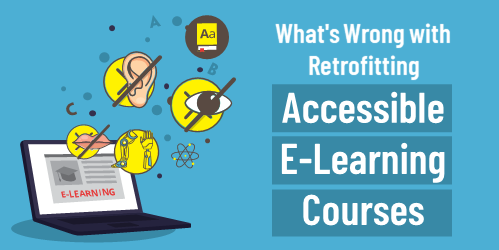What’s Wrong with Retrofitting an Accessible E-Learning Course
Author:
Go to Source

A guest post by Elizabeth Pawlicki, Training Program Manager, Articulate.
Many e-learning designers are challenged because they don’t often build accessible e-learning courses. So, they’re not sure what accessibility means and how it impacts course design.
In a recent webinar, we discussed general ideas around accessible e-learning, common design challenges, and some ways to overcome them. One of the tips was to plan for accessibility from the start because it’s not a good idea to retrofit 508 or WCAG compliance into existing e-learning courses.
An attendee asked, “What’s wrong with retrofitting a course?”
Good question.
Understanding Accessible E-Learning
Imagine a city that already exists full of apartment buildings, skyscrapers, and transit systems. And then the city council implements a law that says there must be a half-acre of park every two square miles.
How will you accomplish that?
You either must tear down what you’ve already built or try to squeeze the bare minimum of acceptable “parkland” into your existing space. Since the parks weren’t an initial consideration, you do what you can to meet minimum guidelines, but you may not meet the aspirational goals of the intent of more parks.
And that’s often the case with e-learning courses that weren’t built with accessibility in mind. The retrofitted courses may appear to meet the minimum requirements but may not offer the best user experience; and they may not actually meet the requirements if all you did after-the-fact was apply accessible features to the original content. And of course, all of that retrofitting costs a lot of extra time and money.
Challenges Retrofitting Accessible E-Learning
There’s a lot that goes into creating an e-learning course like consulting with subject matter experts, writing scripts, developing prototypes, presenting content to stakeholders, and iterating on the prototypes you have created. In the end, you have a published output that everyone has agreed upon.
When you try to retrofit a completed course, it may seem easy and straightforward. But once you begin to uncover how much needs to be undone, redone, and how many people could and should be involved in that process, you’ll find it’s more costly, time-consuming, and downright difficult. This is especially true when you consider the interactive nature of e-learning and how different users access the content.
Therefore, it’s important to consider accessibility as part of the initial production process so that you understand what’s required and build a course that meets everyone’s needs. If you start with accessibility in mind, you’re considering everyone. Everyone will feel included because they are.
Want to learn more:
- Download this free e-book: 6 Best Practices for Designing Accessible E-Learning
- Check out the recorded webinar: 5 Things You Need to Know About Accessibility

Download the fully revised, free 63-page ebook: The Insider’s Guide to Becoming a Rapid E-Learning Pro
Upcoming E-Learning Events
- October 6: Amsterdam. 10 Production Tips from the E-Learning Challenges by David Anderson. Register here.
- October 21: Sydney. 3-Hour Articulate Virtual Event: 10 Production Tips from the E-Learning Challenges, Creating Engaging Software Training in Rise 360, and more. Register here.
- October 29: ATD Nashville. Here’s Why You Need an E-Learning Portfolio.
Free E-Learning Resources
 |
 |
 |
|
Want to learn more? Check out these articles and free resources in the community. |
Here’s a great job board for e-learning, instructional design, and training jobs |
Participate in the weekly e-learning challenges to sharpen your skills |
 |
 |
 |
|
Get your free PowerPoint templates and free graphics & stock images. |
Lots of cool e-learning examples to check out |
Getting Started? This e-learning 101 series and the free e-books will help. |
